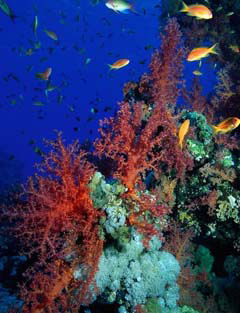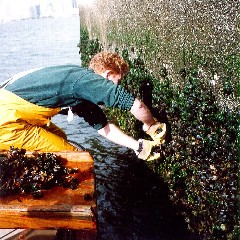|
|

 |
 |

Coastal Ecosystem Science |
Authorizing Mandates | Techniques | Projects
 |
|
|
Lionfish, whose distribution had been limited to the Pacific but which recently have been found off the coast of Georgia, are an example of invasive species studied by NOAA's program of coastal ecosystem science.
|
 |
|
An ecosystem is an ecological community comprised of biological, physical, and chemical components, considered as a unit. Coastal ecosystem science is the study of inter-relationships among the living organisms, physical features, bio-chemical processes, natural phenomena, and human activities in coastal ecological communities. At NOAA's National Ocean Service (NOS), coastal ecosystem science centers on the study of five categories of ecosystem stressors:
- Climate change, such as increases in sea level and ocean temperature;
- Extreme natural events, such as hurricanes, droughts, and harmful algal blooms;
- Pollution, such as excess nitrogen from agricultural and urban runoff;
- Invasive species, such as the lionfish and zebra mussel; and
- Land and resource use, such as over-harvested fisheries.
Authorizing Mandates
Six laws and one executive order authorize most of NOS coastal ecosystem science activities. They are the (1) Estuary Restoration Act; (2) Harmful Algal Bloom and Hypoxia Research and Control Act of 1998; (3) Nonindigenous Aquatic Nuisance Prevention and Control Act of 1990; (4) National Invasive Species Act of 1996; (5) National Coastal Monitoring Act; (6) National Marine Sanctuaries Act; and (7) Coral Reef Protection Executive Order.
 |
|
|
Using remote sensing to map coral reefs in remote areas is a focus of NOAA's program of coastal ecosystem science. This is Pearl & Hermes Atoll in the Northwestern Hawaiian Islands.
|
 |
|
Techniques
NOS uses research, monitoring and assessments to better understand and apply its knowledge of stress factors on coastal ecosystems. The programs and projects that support this effort are lengthy. They span from broad ecosystem-wide and watershed-scale to microbiological and analytical chemistry projects that delve into DNA analysis and bio-chemical reactions. To synthesize the array of many science investigations on an ecosystem scale, NOS develops integrated assessments. These describe the ecosystem, assess its current condition or health, forecast future ecological health based on current management, and evaluate alternative management options and their consequences.
Projects
For NOS, understanding the ecological effects of environmental stressors is a priority in those ecosystems and those areas where responsibilities are mandated by legislation or executive order. These include coral reef ecosystems, the nation's estuaries, 13 national marine sanctuaries, 26 national estuarine research reserves (NERRS), and ocean ecosystems. The focus of NOS coastal ecosystem science is summarized below.
 |
|
|
Coral reef ecosystems, like this one, are complex resources that contribute to biological diversity, fisheries production, coastal protection, tourism, maritime and cultural heritage, and human sustenance.
|
 |
|
Coral Reefs
NOS coastal ecosystem science works to understand the extent of and reasons for the decline of coral reefs and to provide managers with more effective ways to protect them. Research projects examine interactions between natural factors, human activities and coral health. Some specific projects include:
- Characterizing and assessing the distribution of coral reef habitats and the likelihood that particular species live in those habitats;
- Assessing habitat changes in and around coral reefs using remote sensing technology and analysis;
- Developing spatial recovery models to assess injuries to coral reefs;
- Characterizing the Tortugas Ecological Reserve, including the establishment of a baseline to study the effect of creating the reserve; and
- Documenting the health and condition of coral reefs.
Estuaries
 |
|
|
The bright green water in the Potomac River estuary is result of a dense bloom of cyanobacteria. This is an example of one of many harmful algae blooms studied in NOS's coastal ocean science program.
|
 |
|
The NOS approach to estuary research is to produce information that increases understanding of these complex coastal systems and improves the ability to protect and restore habitats within them. Estuary research is grouped into four categories:
ecosystem structure and function, human health, habitat mapping, and large-scale trend analysis and indicators. Work in estuaries includes the national estuarine research reserves (discussed below). Examples of estuary research include:
 |
|
|
A NOS scientist collects mussels in San Diego Bay, California as part of long-term monitoring to compare contaminant concentrations with other coastal locations.
|
 |
|
National Marine Sanctuaries
Within the nation's marine sanctuaries, NOS coastal ecosystem science aims to develop integrated assessments in support of the national marine sanctuary science plan. Top priorities of the plan are the need to understand (1) the status and trends of sanctuary resources on local, regional, and national scales; (2) the nature, level, and trends of human uses within each sanctuary; and (3) the nationally significant themes at the sanctuary level such as essential habitat identification, biodiversity, and conservation. Some projects include:
- Conducting habitat mapping and fish habitat utilization studies in Gray's Reef National Marine Sanctuary;
- Defining the biogeography of the central and northern California national marine sanctuaries;
- Evaluating critical offshore habitats and their susceptibility to fishing/harvest impacts at the Olympic Coast National Marine Sanctuary; and
- Determining injury and restoring injured seagrass beds in the Florida Keys National Marine Sanctuary and in other U.S. territorial waters.
National Estuarine Research Reserves
 |
|
|
NOS scientists conduct research on tidal flats in Alaska's Kachemak Bay National Estuarine Research Reserve.
|
 |
|
The goal of NOS ecosystem science at NERRS sites is to support research and management efforts at each reserve. Some projects include:
- Compiling environmental contaminant data at various NERRS sites and assessing the environmental conditions at those sites;
- Developing citizen monitoring protocols for salt marsh restoration in North Carolina and California NERRS sites;
- Conducting research on the role of tidal flat primary production in the ecosystem ecology of Kachemak Bay, Alaska.
Oceans and Coastal Waters
The coastal ocean encompasses a broad range of saltwater ecosystems, including estuaries, coral reefs, rocky shores, gravel shores, sandy shores, mud flats, marshes and mangrove forests. These ecosystems exist where streams and rivers meet the sea and where tides and coastal currents mix. NOS works to understand and anticipate changes in coastal ecosystems as they become stressed. Example projects include:
- Predicting fishery populations for pollock in the Bering Sea, for cod and haddock on Georges Bank in the North Atlantic, and for salmon in the Pacific Northwest;
- Studying the effects, impacts and distribution of disease in fish resources in coastal U.S. waters;
- Integrated assessments of marine protected areas along the Pacific coast of North America;
- Evaluating pharmaceuticals and steroids as environmental contaminants in coastal waters; and
- Using forensic analyses to detect illegal sales of game fish, and the taking of managed fish, during periods of fishery closure.
(top)
|
NOS uses research, monitoring and assessments to better understand and apply its knowledge of stress factors on coastal ecosystems.
The NOS approach to estuary research is to produce information that increases understanding of these complex coastal systems and improves the ability to protect and restore habitats within them.
Throughout the U.S. coastal and ocean regions, NOS studies how to improve ecological and oceanographic predictions for fisheries management.
|






